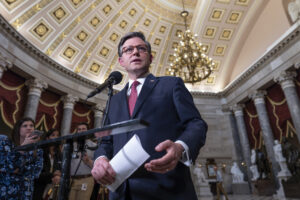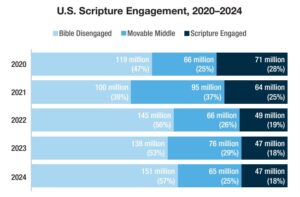
ALPHARETTA, Ga. (BP)–Ed Stetzer, vice president of research and ministry development at LifeWay Christian Resources, exhorted about 180 North American Mission Board employees to “be known as the entity that stands with young church planters, even when they make stupid mistakes.”
At the invitation of NAMB President Kevin Ezell, Stetzer spoke at the mission board in mid-March, drawing from his most recent book, “Viral Churches: Helping Church Planters Become Movement Makers,” coauthored with Warren Bird, research director at the Dallas-based Leadership Network.
Stetzer used Ephesians 3:10 as his scriptural base in his three-hour presentation. He noted that “while there’s no verse in the Bible that says, ‘Thou shall plant churches,’ the New Testament church was a church-planting church. It was their practice. Asking the early Christians to plant churches is like asking water to be wet.
“God didn’t choose art or music or even mission agencies to plant churches. He chose the church. Churches planting churches — through multiplication, not addition — is the key.”
Stetzer said church planting has become trendy: Last year, 4,000 new Protestant churches were planted across the U.S. while 3,500 closed. So in a shift from the past, more Protestant churches are being planted than are closing. The commonly quoted statistic that 80 percent of all new church starts fail is a myth, Stetzer said, citing a NAMB research project reported in Viral Churches involving planters from several denominations.
Comparing church planting to childbirth, Stetzer called church planting messy.
“Both are wonderful things, but they are bloody, painful, messy, and there can be a lot of yelling,” he said. “But you’re ready to have another one because it’s such a wonderful experience.
“Some Baptists have forgotten the joy of childbirth when it comes to new churches. Unfortunately, some traditional church members of the Southern Baptist Convention see young church planters as the competition.”
Stetzer said Southern Baptists choose church planters who are atypical, self-starting mavericks and then wonder why they can be challenging at times.
“If you at NAMB want to be known as the agency that loves young church planters, love them differently than you love pastors because they are different than pastors. Church planters have a different constitution, a different wiring than the rest of us,” Stetzer said. “That’s why they’re church planters.”
Saying that more Protestant churches as a whole need to be engaged in church planting, Stetzer noted that only 3 percent of them are involved in church planting, which is commonly accepted as the best way to share the Gospel and win the world for Christ. Stetzer said church planting and evangelism go hand in hand.
“Church planting should be promoted as a normal activity of Christians. Disciples, groups, ministries and churches must reproduce. But church planting is an abnormal experience to most of our churches,” Stetzer said. “So why should we not be surprised that there’s not a lot of church reproduction going on?
“All healthy things reproduce. But we have a lot of churches that have allowed themselves to be the cul de sac on the Great Commission Highway. I don’t want my church or yours to be that.”
Stetzer said NAMB and other SBC leaders must re-instill a culture of reproduction in churches, adding that over time, churches become more inward-focused unless there’s some provoking from the outside.
“We have had the expectation of church reproduction before, but we have lost it. One reason we lost it is that we have taught our churches too often that missions is a function that we outsource to somebody else.
“We have taught the churches that their job is to ‘Pray, pay and get out of the way.’ What we end up with is they become convinced that their role is to be funders of missions, not participants in missions. Half of our churches become spenders for missions rather than engaged in missions. Baptists can be missions-minded without being missionally engaged.”
And while SBC funding for church planting is “embarrassingly low,” Stetzer said funding ultimately has no correlation to church planting success or survivability.
“You can’t buy your way into church multiplication,” Stetzer said. “I’m a believer in funding church planters well. And while funding assists and catalyzes church planting, it’s not the total fix but only one of the factors we need to confront. When you don’t have the systems of church multiplication in place, you can throw money away.”
Stetzer concluded by calling on NAMB to celebrate church planters as heroes.
“What we celebrate we become. We need to talk about how many we send out, not how many we got in. Help Southern Baptists to fall in love with their church planters. For too long, people have looked down on bivocational pastors, unpaid pastors and on non-seminary-trained pastors. NAMB needs to be one of those places that says, ‘We’re going to bless all kinds of church planters.’
“I know it’s been tough … at NAMB,” Stetzer said. “But in the fullness of His sovereignty, God has prepared the Southern Baptist Convention to now say, ‘We’re going to value church planting.’ What NAMB now needs to do is ask how it can seize this moment. Let NAMB be the one to get behind significant church planting leaders and networks.”
–30–
Mickey Noah writes for the North American Mission Board.















